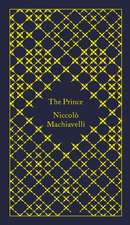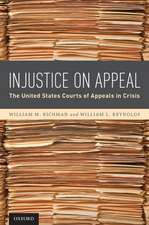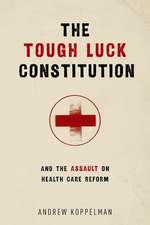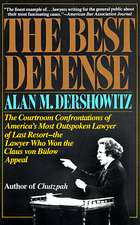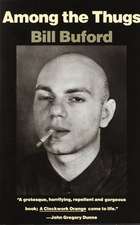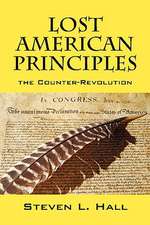A Trial by Jury
Autor D.GRAHAM BURNETTen Limba Engleză Paperback – 30 sep 2002
Offering a compelling courtroom drama and an intimate and sometimes humorous portrait of a fractious jury, A Trial by Jury is also a finely nuanced examination of law and justice, personal responsibility and civic duty, and the dynamics of power and authority between twelve equal people.
Preț: 100.35 lei
Nou
Puncte Express: 151
Preț estimativ în valută:
19.20€ • 20.10$ • 15.98£
19.20€ • 20.10$ • 15.98£
Carte disponibilă
Livrare economică 10-24 martie
Preluare comenzi: 021 569.72.76
Specificații
ISBN-13: 9780375727511
ISBN-10: 0375727515
Pagini: 208
Ilustrații: 2 DIAGRAMS
Dimensiuni: 130 x 203 x 15 mm
Greutate: 0.2 kg
Editura: Vintage Publishing
ISBN-10: 0375727515
Pagini: 208
Ilustrații: 2 DIAGRAMS
Dimensiuni: 130 x 203 x 15 mm
Greutate: 0.2 kg
Editura: Vintage Publishing
Notă biografică
D. Graham Burnett is a historian of science and the author of Masters of All They Surveyed. After graduating from Princeton University, he was a Marshall Scholar at Trinity College, Cambridge. In 1999, Chicago’s Newberry Library awarded him the Nebenzahl Prize in the History of Cartography. A 1999–2000 Fellow at the Center for Scholars and Writers at the New York Public Library, he has taught at Yale and Columbia Universities, and is currently an assistant professor in the history department at Princeton.
Extras
How It Ended
I have on my desk at this moment twelve five-by-seven ruled index cards. On each of them the same two words appear: "not guilty." Eight are written in pen, four in pencil. On eight of them the words appear along a single line, on two the words are perpendicular to the ruling, and on two they are scrawled diagonally (one of these last has been written on an inverted card, turned so that the red top line and margin are at the bottom). Three are in all caps, three have only the initial letters capitalized, three are all lowercase, two others show the "N" capitalized but not the "g." In the last of them the word "not" appears in all caps, but the word "guilty" is all lowercase.
By dint of these varied inscriptions, made in silence in a few tense moments, Monte Virginia Milcray walked out of Part 24 of the New York State Supreme Court, got into the elevator, and descended to the cold wetness of Centre Street a little before noon on February 19, 2000. I preceded him by several minutes, getting into a cab with my duffel bag and riding the dozen blocks home to my wife, with whom I had not spoken in four days. The cards were folded in the breast pocket of my navy blazer. I was crying.
The twelve cards represent the potent residue of the most intense sixty-six hours of my life, a period during which I served as the foreman of a jury charged to decide whether Monte Milcray was guilty of murdering Randolph Cuffee. During that period, twelve individuals of considerable diversity engaged in a total of twenty-three hours of sustained conversation in a small, bare room. We ran the gamut of group dynamics: a clutch of strangers yelled, cursed, rolled on the floor, vomited, whispered, embraced, sobbed, and invoked both God and necromancy. There were moments when the scene could have passed for a graduate seminar in political theory, others that might have been a jujitsu class. A few came straight out of bedlam. Before it was over, we had spent three nights and four days continuously attended by armed guards (who extended their affable surveillance into all lavatories); we had been shuttled to outlying hotels, into rooms with disconnected phones and sinks in which we washed our clothes; we had watched one juror pulled from our midst and rushed to the hospital (a physical collapse, caused by some combination of missing medication and the crucible of the deliberations), another make a somewhat halfhearted effort to escape (he was apprehended), and a third insist on her right to contact her own lawyer to extricate her from the whole affair (she was threatened with contempt).
During significant stretches in this trying time, we considered two weeks of testimony in The People of New York v. Monte Virginia Milcray and struggled to understand two things: what happened in Cuffee's apartment on the night of August 1, 1998, and what responsibilities we had as citizens and jurors.
It is my intention to tell this story as best I can. I am doing so for several reasons, among them two in particular: first, because there are things to be learned from the way events unfolded (about people, about the law, about justice, about truth and how we know it), and, second, because the jury room is a most remarkable--and largely inaccessible--space in our society, a space where ideas, memories, virtues, and prejudices clash with the messy stuff of the big, bad world. We expect much of this room, and we think about it less often than we probably should.
Before I embark on this task, however, a few words of warning. There are really two stories here: that of the case itself--a trial story, a courtroom story, a drama focused around a violent death; and that of the deliberations--the story of what happened behind the closed door of the jury room. Each of these stories is complex, and they are of course entangled. I set out to write this book in order to tell the latter, but to do so I must rehearse elements of the former. Let me be clear, though: it is by no means my intention to retry the case in a personal memoir. The case is closed. In writing this book, I have made no additional investigations of the events at issue, I have not revisited the records of the trial, and I have not interviewed any of the people involved. All of that was tempting, and would certainly have been interesting, but my sense has been that to embark on such digging would have been, inevitably, to put the trial on trial, to lose myself again in the twisting labyrinth of unrecoverable fact that we negotiated in the jury room. I would have begun to extend that labyrinth, to open new rooms and passages. And this was not the aim. I am sure there is more to the maze than I have seen (when is there not?), but by keeping notes during the weeks of the trial, I laid a thread along the path we took together as jurors, and that is the thread I will follow here.
A further disclaimer: what I am writing is my own story of the deliberations. I have no idea what those who shared the experience with me would make of this document should they pick it up. Or let me speak more frankly. I am sure each of them would contest my story in different ways--argue, perhaps, I did not represent them rightly; assert that this part over here was not that way; draw to my attention things I have forgotten. If one learns anything from a criminal trial under the adversary system, it is that sincere folk can differ vehemently about events, and that there is seldom any easy way to figure out what actually went on.
At different moments while writing this account--much of it longhand in a notebook during the weeks following the acquittal--I have closed my eyes and tried to imagine what the small, bare jury room looked like from the perspective of the others. We sat around the same table, but the room must have appeared slightly different to each. I try to see in my mind's eye how things looked from the other side--the door on one's right, the winter windows at one's back.
That is where Dean Kossler sat. What would he think of this narrative? Dean--the big, solid, former bull-riding cowboy turned vacuum-cleaner repairman. Dean--the six-foot-three-inch born-again God-fearing veteran of the U.S. armed forces. When I first noticed him, in the early days of jury selection, he was spitting tobacco juice behind the radiator by the elevator during a break. He had thin brown hair slicked back and a manly mustache; he wore a weath- ered pair of work boots. A blowhard contractor of some sort, I assumed, and I pegged him, without much thought, as a poster boy for Susan Faludi's tragic tale of the white working-class male--big chest, big gut, big debt. I called him, irreverently, "the Faludiman" in my notes. What did I know? Before the trial ended, he had blown my stereotype (indeed, any stereotype) wide open.
What would he say about all this? About what I have written?
Or Felipe Rodriguez? I originally wrote to myself that he seemed "sweet and shy." He giggled often, wore a large number of braided string bracelets, seemed lost in his giant orange parka. I came to loathe him. By the end, he had thrown much into question for me: not least, my confidence in jury trials. Are there some citizens not clearly able to distinguish daytime television from daily life? Apparently there are. Should they participate in deciding on the freedom of another person? Maybe. I doubt he remembers things as I do.
And there were others, of course. Leah Tennent, the self-possessed and buoyantly bohemian young woman with whom I read Wallace Stevens poems in the back of the bus. Olivelle "Vel" Tover, the youthful, clear-eyed black woman with an elaborate braided coiffure who studied a manual of purgative and rejuvenating fasts in the waiting area; we discussed together the value of self-denial, of cleansing the body through the strictest diets. Rachel Patis, the solid, quiet, unflappable West Indian woman who volunteered at her local police precinct and wore blouses trimmed with lace; she moved slowly, sat very still, seemed like an older lady. Patricia Malley, "Pat," the dyed-blonde tough-girl in the tight black jeans who spoke loudly and much, often well. She seemed instantly animated in Dean's company, adjusted her eyeliner, laughed easily and with gusto.
And so on: James Lanes (who went by Jim), Jessica Pol- lero, Suzy O'Mear, Paige Barri, and Adelle Benneth. This last, like me, was a professor of history. More improbable still, she focused, as I do, on the history of science, and had, like me, a particular interest in exploration and travel narratives (though she worked on the medieval period and I on the modern). A striking coincidence, all this.
All together, then, we were two professional histo- rians (Adelle and I), two ad-copy writers (Jessica and Jim), a globe-trotting Gen-X software developer (Leah), an industrial-vacuum-cleaner repairman with a rodeo tattoo who moonlighted in car-stereo installation (Dean), an interior decorator (Paige), an "independent marketing executive" and part-time security guard (Rachel), an actress (Pat, but was she also a bartender?), the manager of certain commercial enterprises owned by the "Mattress King of Miami" (Vel), and a couple of others (Felipe, Suzy) of less clear occupation. Twelve citizens, twelve different characters.
The deliberations were theirs as much as mine. This story, however, is mine alone. Like a witness, I am fallible; I shall surely misremember things. And even if my memory were perfect, what retelling, in a string of words, is not a distressing distortion of the cluttered thickness of things as they happen?
Trials are about this.
I have on my desk at this moment twelve five-by-seven ruled index cards. On each of them the same two words appear: "not guilty." Eight are written in pen, four in pencil. On eight of them the words appear along a single line, on two the words are perpendicular to the ruling, and on two they are scrawled diagonally (one of these last has been written on an inverted card, turned so that the red top line and margin are at the bottom). Three are in all caps, three have only the initial letters capitalized, three are all lowercase, two others show the "N" capitalized but not the "g." In the last of them the word "not" appears in all caps, but the word "guilty" is all lowercase.
By dint of these varied inscriptions, made in silence in a few tense moments, Monte Virginia Milcray walked out of Part 24 of the New York State Supreme Court, got into the elevator, and descended to the cold wetness of Centre Street a little before noon on February 19, 2000. I preceded him by several minutes, getting into a cab with my duffel bag and riding the dozen blocks home to my wife, with whom I had not spoken in four days. The cards were folded in the breast pocket of my navy blazer. I was crying.
The twelve cards represent the potent residue of the most intense sixty-six hours of my life, a period during which I served as the foreman of a jury charged to decide whether Monte Milcray was guilty of murdering Randolph Cuffee. During that period, twelve individuals of considerable diversity engaged in a total of twenty-three hours of sustained conversation in a small, bare room. We ran the gamut of group dynamics: a clutch of strangers yelled, cursed, rolled on the floor, vomited, whispered, embraced, sobbed, and invoked both God and necromancy. There were moments when the scene could have passed for a graduate seminar in political theory, others that might have been a jujitsu class. A few came straight out of bedlam. Before it was over, we had spent three nights and four days continuously attended by armed guards (who extended their affable surveillance into all lavatories); we had been shuttled to outlying hotels, into rooms with disconnected phones and sinks in which we washed our clothes; we had watched one juror pulled from our midst and rushed to the hospital (a physical collapse, caused by some combination of missing medication and the crucible of the deliberations), another make a somewhat halfhearted effort to escape (he was apprehended), and a third insist on her right to contact her own lawyer to extricate her from the whole affair (she was threatened with contempt).
During significant stretches in this trying time, we considered two weeks of testimony in The People of New York v. Monte Virginia Milcray and struggled to understand two things: what happened in Cuffee's apartment on the night of August 1, 1998, and what responsibilities we had as citizens and jurors.
It is my intention to tell this story as best I can. I am doing so for several reasons, among them two in particular: first, because there are things to be learned from the way events unfolded (about people, about the law, about justice, about truth and how we know it), and, second, because the jury room is a most remarkable--and largely inaccessible--space in our society, a space where ideas, memories, virtues, and prejudices clash with the messy stuff of the big, bad world. We expect much of this room, and we think about it less often than we probably should.
Before I embark on this task, however, a few words of warning. There are really two stories here: that of the case itself--a trial story, a courtroom story, a drama focused around a violent death; and that of the deliberations--the story of what happened behind the closed door of the jury room. Each of these stories is complex, and they are of course entangled. I set out to write this book in order to tell the latter, but to do so I must rehearse elements of the former. Let me be clear, though: it is by no means my intention to retry the case in a personal memoir. The case is closed. In writing this book, I have made no additional investigations of the events at issue, I have not revisited the records of the trial, and I have not interviewed any of the people involved. All of that was tempting, and would certainly have been interesting, but my sense has been that to embark on such digging would have been, inevitably, to put the trial on trial, to lose myself again in the twisting labyrinth of unrecoverable fact that we negotiated in the jury room. I would have begun to extend that labyrinth, to open new rooms and passages. And this was not the aim. I am sure there is more to the maze than I have seen (when is there not?), but by keeping notes during the weeks of the trial, I laid a thread along the path we took together as jurors, and that is the thread I will follow here.
A further disclaimer: what I am writing is my own story of the deliberations. I have no idea what those who shared the experience with me would make of this document should they pick it up. Or let me speak more frankly. I am sure each of them would contest my story in different ways--argue, perhaps, I did not represent them rightly; assert that this part over here was not that way; draw to my attention things I have forgotten. If one learns anything from a criminal trial under the adversary system, it is that sincere folk can differ vehemently about events, and that there is seldom any easy way to figure out what actually went on.
At different moments while writing this account--much of it longhand in a notebook during the weeks following the acquittal--I have closed my eyes and tried to imagine what the small, bare jury room looked like from the perspective of the others. We sat around the same table, but the room must have appeared slightly different to each. I try to see in my mind's eye how things looked from the other side--the door on one's right, the winter windows at one's back.
That is where Dean Kossler sat. What would he think of this narrative? Dean--the big, solid, former bull-riding cowboy turned vacuum-cleaner repairman. Dean--the six-foot-three-inch born-again God-fearing veteran of the U.S. armed forces. When I first noticed him, in the early days of jury selection, he was spitting tobacco juice behind the radiator by the elevator during a break. He had thin brown hair slicked back and a manly mustache; he wore a weath- ered pair of work boots. A blowhard contractor of some sort, I assumed, and I pegged him, without much thought, as a poster boy for Susan Faludi's tragic tale of the white working-class male--big chest, big gut, big debt. I called him, irreverently, "the Faludiman" in my notes. What did I know? Before the trial ended, he had blown my stereotype (indeed, any stereotype) wide open.
What would he say about all this? About what I have written?
Or Felipe Rodriguez? I originally wrote to myself that he seemed "sweet and shy." He giggled often, wore a large number of braided string bracelets, seemed lost in his giant orange parka. I came to loathe him. By the end, he had thrown much into question for me: not least, my confidence in jury trials. Are there some citizens not clearly able to distinguish daytime television from daily life? Apparently there are. Should they participate in deciding on the freedom of another person? Maybe. I doubt he remembers things as I do.
And there were others, of course. Leah Tennent, the self-possessed and buoyantly bohemian young woman with whom I read Wallace Stevens poems in the back of the bus. Olivelle "Vel" Tover, the youthful, clear-eyed black woman with an elaborate braided coiffure who studied a manual of purgative and rejuvenating fasts in the waiting area; we discussed together the value of self-denial, of cleansing the body through the strictest diets. Rachel Patis, the solid, quiet, unflappable West Indian woman who volunteered at her local police precinct and wore blouses trimmed with lace; she moved slowly, sat very still, seemed like an older lady. Patricia Malley, "Pat," the dyed-blonde tough-girl in the tight black jeans who spoke loudly and much, often well. She seemed instantly animated in Dean's company, adjusted her eyeliner, laughed easily and with gusto.
And so on: James Lanes (who went by Jim), Jessica Pol- lero, Suzy O'Mear, Paige Barri, and Adelle Benneth. This last, like me, was a professor of history. More improbable still, she focused, as I do, on the history of science, and had, like me, a particular interest in exploration and travel narratives (though she worked on the medieval period and I on the modern). A striking coincidence, all this.
All together, then, we were two professional histo- rians (Adelle and I), two ad-copy writers (Jessica and Jim), a globe-trotting Gen-X software developer (Leah), an industrial-vacuum-cleaner repairman with a rodeo tattoo who moonlighted in car-stereo installation (Dean), an interior decorator (Paige), an "independent marketing executive" and part-time security guard (Rachel), an actress (Pat, but was she also a bartender?), the manager of certain commercial enterprises owned by the "Mattress King of Miami" (Vel), and a couple of others (Felipe, Suzy) of less clear occupation. Twelve citizens, twelve different characters.
The deliberations were theirs as much as mine. This story, however, is mine alone. Like a witness, I am fallible; I shall surely misremember things. And even if my memory were perfect, what retelling, in a string of words, is not a distressing distortion of the cluttered thickness of things as they happen?
Trials are about this.
Recenzii
“[Burnett] is a graceful, economical writer, with a sharp eye for detail and a nuanced feel for character. . . . Irresistible.” —The New York Times Book Review
“Immensely readable.” —The Washington Post
“Burnett manages to paint vivid portraits of his fellow-jurors and examine the knottier issues of class, race, and gender that complicate the justice system’s search for objective truth.” —The New Yorker
“A pleasure to read . . . Illuminating and, ultimately, uplifting.” —The Nation
“Never have we been privy to actual jury room deliberations in all of their stark human complexity and perversity — and certainly never under the guidance of a sensibility, intelligence, and narrative skill like Mr. Burnett’s.” —New York Law Journal
“Immensely readable.” —The Washington Post
“Burnett manages to paint vivid portraits of his fellow-jurors and examine the knottier issues of class, race, and gender that complicate the justice system’s search for objective truth.” —The New Yorker
“A pleasure to read . . . Illuminating and, ultimately, uplifting.” —The Nation
“Never have we been privy to actual jury room deliberations in all of their stark human complexity and perversity — and certainly never under the guidance of a sensibility, intelligence, and narrative skill like Mr. Burnett’s.” —New York Law Journal
Descriere
Offering a compelling courtroom drama and an intimate and sometimes humorous portrait of a fractious jury, "A Trial by Jury" is also a finely nuanced examination of law and justice, personal responsibility and civic duty, and the dynamics of power and authority between 12 equal people.

